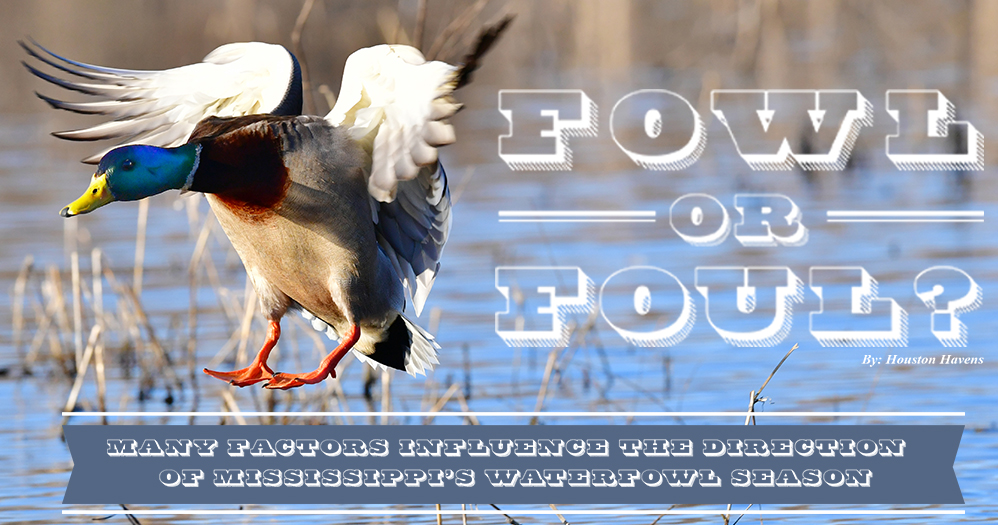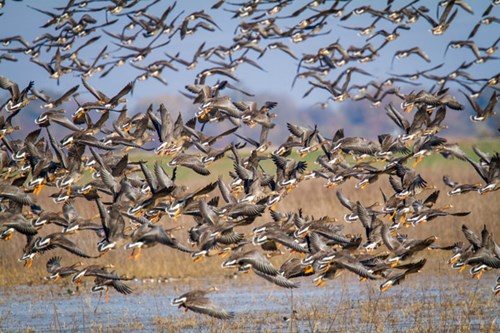Mississippi Outdoors: Fowl or Foul?
12/1/2017 12:06:08 PM
By Houston Havens

As early fall arrives, one of the more common questions wildlife biologists are asked is: What kind of hunting season are we going to have?
The most appropriate answer: Well, it depends…
Multiple factors must be taken into account. Forecasting hunting success is not likely to become its own profession anytime soon, but science and technology are constantly advancing to provide better tools and information which biologists and hunters can use to make decisions and manage expectations.
Here are some of the factors that can affect the Mississippi duck season:
Breeding Populations and Associated Habitat
The “fall flight,” in waterfowl terms, is used to describe the relative number of birds that will migrate south during the fall and winter within a given year. Because most waterfowl that winter in Mississippi are migratory, it makes sense to look north to start any analysis of what we might see in the state this winter.
The waterfowl breeding grounds, in general, refer to the northern United States and Canada, where most ducks breed, nest, and raise their young. Adult ducks that survive the winter migrate back to the breeding grounds each spring, often close to the area where they were raised. In May, biologists begin aerial surveys across the vast breeding grounds to count the breeding pairs and the available wetlands. These surveys are used to estimate a total breeding duck population for the year, which is released to the public during late summer.
The estimates of duck numbers and available wetland habitat are used to determine future waterfowl hunting season frameworks. Biologists and duck hunters pay close attention to the reports as the first indication of how the hunting season might unfold. While these numbers are important, the breeding duck population is only the first puzzle piece.
After the May breeding population surveys are completed and summer arrives, a key fall flight component remains to be accomplished: reproduction. Hens begin to nest while their male counterparts leave to begin molting (replacing their feathers). Summer nesting and subsequent raising of broods can be a vulnerable time for ducks. Success is dependent upon the quality and quantity of both grassland and wetland habitats.
Many duck species are grassland nesters, which prefer upland native grass habitats in close proximity to wetlands. This is why the Conservation Reserve Program and other prairie grassland programs are so important in the breeding grounds, where intensive farming practices are often a limiting factor for nesting habitat availability. Wetland habitat must also be maintained by summer rainfall for hens to have quality brood-rearing and foraging areas. Without abundant grasslands and wetlands throughout the summer to facilitate nest success and brood survival, the number of ducks in the fall flight will be heavily impacted. Not only do these factors drive overall duck numbers, but juvenile ducks generally have higher harvest rates than adults, which could have an important effect on duck hunting success.

Fall and Winter Weather
Following summer reproduction and after juvenile ducks are capable of flight, the days begin to get shorter, signaling a season change. While many ducks will begin to migrate southward based on day length and time of year, the timing and magnitude of migrations are also heavily driven by weather.
Consistent cold fronts sweeping from north to south are ideal for duck migrations, but the intensity and duration of cold weather from the north also play an important role. Snow and ice coverage of wetlands and dry field for-aging areas will have a stronger influence on duck migration than a single night of below-freezing temperatures. Some ducks will stay put in an attempt to outlast a cold front, especially if food is abundant.
Ducks also may migrate southward for a short time, then follow a warming trend back north if cold fronts are inconsistent. Another important influence winter weather has on ducks is the requirement to forage heavily during cold temperatures. In order to maintain body temperatures during cold weather, ducks are forced to feed more heavily for increased energy intake. For duck hunters, this can increase duck movements, as well as the level of risk ducks will tolerate to find food.
Winter Habitat
In the South, ducks forage almost exclusively in wetlands, which means wetland habitat availability in Mississippi is a key element for holding ducks during the winter. In the 2016 summer and early fall, the Lower Mississippi Alluvial Valley (LMAV) experienced some of the driest conditions in years. As a result, many biologists theorized that early fall migrating ducks passed over these portions of Mississippi, Arkansas, and Louisiana and headed farther south to the coastal marshes along the Gulf of Mexico, where wetland habitat conditions were much better. This theory was supported by waterfowl survey estimates from November 2016.
As winter rains arrived, habitat conditions improved in the LMAV, and duck numbers responded accordingly. Of course, there were wetlands available throughout parts of the Mississippi Delta during this time, and some ducks were using the available habitat. However, the bulk of the landscape was dry and likely unattractive to a large number of ducks passing overhead.
When wetlands are available for ducks during winter, the next necessary component is having abundant food available in the wetlands. Landowners and land managers should remember that ducks are capable of wide-ranging movements in their daily travels, and, therefore, will often assess habitat suitability on a scale much larger than a single property. This magnifies the importance of knowing what types of wetlands are being provided in the general area, and what may be needed to supplement surrounding properties. Wetland habitat diversity in an area can be as important as wetland habitat amount.
Hunter Flexibility
Maintaining flexibility in timing, location, and methods can be a tremendous asset to a duck hunter. In the pursuit of a suite of birds that reacts to minor changes in weather, water levels, wind, and other factors, hunters should always be mindful of the environmental conditions and how or why they might be affecting duck behavior. A hunter’s willingness to try something new when things are not going well is sometimes all it takes to turn failure into success. Hunting the same place, the same way over and over can produce desired results. But if not, be flexible.
Houston Havens is the Waterfowl Program Coordinator for the MDWFP. To subscribe to Mississippi Outdoors, call toll-free 1-888-874-5785.









